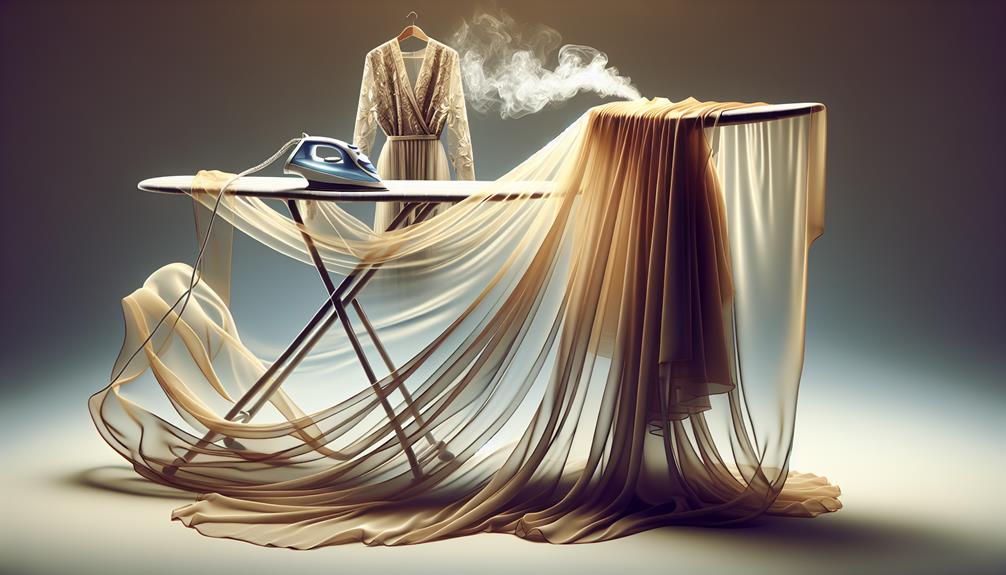Yes, I can iron chiffon, but I have to be extra careful because it's such a delicate fabric. First, I always check the care label for specific instructions. I use the lowest heat setting on my iron to avoid damage and always place a thin cotton cloth between the iron and the chiffon to protect it. I test the iron on a small, hidden part of the fabric first to make sure it doesn't scorch. Ironing chiffon is all about gentle, quick strokes to smooth out those wrinkles without harming the fabric. There's more to learn about keeping chiffon in top shape!
Table of Contents
Key Takeaways
- Chiffon can be ironed, but it requires a low heat setting to prevent damage.
- Always use a press cloth to shield the chiffon from direct heat.
- Test the iron on a small, inconspicuous area of the fabric first.
- Keep the iron moving and use gentle, light strokes to avoid scorching.
- Allow the chiffon to cool on a flat surface after ironing to maintain its shape.
Understanding Chiffon Fabric
Chiffon is a lightweight, sheer fabric that's often made from silk or synthetic materials like polyester. Its delicate and airy nature gives it a beautiful drape and a soft, silky feel, making it a popular choice for evening wear, blouses, and scarves. Because of its thin threads and tight weave, chiffon has a slightly rough texture and a stretchy quality, although it's less elastic than other fabrics.
The unique characteristics of chiffon come from its production process. The fabric is woven with alternate S- and Z-twist crepe yarns, which causes slight puckers that make chiffon somewhat rough to the touch. This method also contributes to its stretch and makes it notoriously difficult to work with, especially when sewing.
Understanding chiffon's composition and weave is crucial when considering how to care for it, including cleaning and ironing. Its fragile nature requires gentle handling to maintain its shape and texture. Whether you're dealing with a synthetic or silk chiffon, each type demands specific care techniques to prevent damage and preserve its elegant appearance. This knowledge is essential if you're looking to master working with or maintaining chiffon garments effectively.
Pre-Ironing Preparation Tips
Before I even think about ironing chiffon, I always check the fabric care label to avoid any mishaps.
It's crucial to select the correct heat setting on my iron because chiffon can be pretty delicate.
Getting these basics right saves me a lot of trouble down the line.
Check Fabric Care Label
Always check the fabric care label for specific ironing instructions before you start ironing your garment. This step is crucial. Labels provide essential details that dictate whether your chiffon can safely meet the heat of an iron.
If the label says 'dry clean only,' you'll want to steer clear of ironing it yourself to avoid damage. Ignoring these instructions could spell disaster for delicate fabrics like chiffon, which are prone to melting or warping under incorrect temperatures. The label might also mention whether steam is permissible or if a protective cloth should be used during the ironing process.
Paying attention to these details ensures you handle your garment correctly and maintain its quality and appearance.
Select Correct Heat Setting
To ensure your chiffon doesn't get damaged, select a low heat setting on your iron. Chiffon's delicate fibers can easily burn or melt with too much heat. I always start with the lowest setting and gradually increase if necessary. It's crucial to test a small, inconspicuous area first. This step lets me check if the fabric reacts poorly. Remember, patience is key here. You're not just pressing clothes; you're preserving the integrity of a fine material.
Also, consider using a pressing cloth. It adds an extra layer of protection between the iron and your chiffon. This simple tool can prevent a multitude of sins, including unwanted sheen or scorch marks. Trust me, it's a lifesaver.
Selecting the Right Iron Settings
Choosing the right iron settings is crucial when you're dealing with delicate fabrics like chiffon. It's not just about the heat; the entire setup of your iron can affect the outcome. I've learned that it's essential to familiarize myself with the specific features of my iron. Some irons have a dedicated silk or synthetic setting, which is typically suitable for chiffon. This setting usually ensures the iron doesn't get too hot, which can easily damage or melt the fabric.
If your iron doesn't have fabric-specific settings, aim for the lowest heat option. Testing on a small, inconspicuous area first can save you from a major mishap. It's also a good idea to check whether your iron is clean and free of any residue that could transfer onto the chiffon. Residue at high temperatures can cause more harm than direct heat.
I also make sure that the steam settings are adjusted properly. Chiffon can handle some steam, but too much moisture can leave water stains. A light steam can help get the wrinkles out without saturating the fabric. Remember, mastering these settings isn't just about preserving your fabric; it's about achieving that perfect, crisp look effortlessly.
Step-by-Step Ironing Guide
Now that we've set the iron correctly, let's walk through the steps to iron chiffon effectively. Ironing chiffon can be tricky due to its delicate nature, but with precise movements and the right technique, you can achieve smooth, wrinkle-free fabric without damage.
Here's a straightforward guide to help you master the process:
| Step | Action | Tip |
|---|---|---|
| 1 | Lay the chiffon flat | Use an ironing board and lay the chiffon piece flat. Ensure no other fabrics are underneath to avoid unintended texture transfers. |
| 2 | Test the iron's heat | Begin by gently pressing a small, inconspicuous area of the chiffon to test the iron's heat. This helps prevent scorching the fabric. |
| 3 | Iron in sections | Move the iron slowly across the chiffon in sections. Avoid letting the iron sit in one spot for too long to prevent heat damage. |
Always keep the iron moving and focus on smoothing out wrinkles gently without pressing too hard. The fabric's integrity is paramount, so light strokes are key. Also, ensure you iron both the front and back of the fabric for an evenly crisp appearance. Following these steps, you'll find that ironing chiffon isn't just possible; it's actually quite doable with the right approach.
Using a Press Cloth
When ironing chiffon, it's essential to use a press cloth to protect the fabric.
I'll show you how to pick the right cloth and where to place it.
We'll also look at why using a press cloth really makes a difference.
Choosing the Right Cloth
To protect your chiffon while ironing, always use a press cloth. It's crucial to select the right type. A good choice is a lightweight, non-textured fabric like muslin or a clean cotton dish towel. These materials are thin enough to allow heat to pass through but will shield your delicate chiffon from direct contact with the iron. This prevents the shiny marks that high heat can cause and also reduces the risk of melting or distorting the fabric.
Don't use colored cloths as they could transfer dye onto your chiffon, especially under high heat. Stick to white or light-colored press cloths to play it safe. Remember, the goal is to protect your fabric, not to introduce new problems.
Press Cloth Placement
After choosing the right press cloth, it's important to position it correctly over the chiffon before ironing. Here's how I do it:
- Lay the Chiffon Flat: Start by laying your chiffon garment flat on the ironing board. Smooth out any wrinkles with your hands.
- Position the Press Cloth: Place your selected press cloth directly over the area of chiffon you plan to iron. Ensure it covers completely to avoid direct contact between the iron and chiffon.
- Check Alignment: Double-check that the cloth is centered and aligned with the edges of the chiffon beneath it.
- Secure Placement: Lightly tap the edges of the press cloth to ensure it stays in place as you begin to iron. This prevents shifting and potential fabric damage.
Benefits of Pressing Cloth
Using a press cloth offers several advantages, such as protecting delicate chiffon from direct heat damage. It also ensures that no unwanted sheen develops on the fabric surface, a common issue when ironing at higher temperatures. I've found that a press cloth helps distribute the heat more evenly, which is crucial for getting a smooth finish without scorching the material.
Moreover, it acts as a barrier against any potential stains or dirt from the iron plate. This is especially important if you're working with light-colored or easily marked fabrics. I always recommend using a thin cotton or muslin cloth, as they allow the heat to pass through effectively while still shielding the chiffon. It's a simple step that significantly ups your ironing game.
Alternative Wrinkle-Removal Methods
If you're hesitant to iron chiffon, consider alternative methods like steaming to remove wrinkles safely. Steaming is gentle and effective, providing the moisture needed to smooth out creases without the harsh contact of an iron.
But let's dive into a few more practical alternatives that you might find handy:
- Hanging in the Bathroom: Simply hang your chiffon garment in the bathroom while you take a hot shower. The steam generated naturally helps relax the fabric's fibers, easing out those wrinkles without any direct heat.
- Using a Damp Towel: Lay the chiffon flat and place a damp towel over it. Gently press down to transfer some moisture. After a few minutes, remove the towel and smooth out the garment with your hands.
- Spray Bottle Method: Fill a spray bottle with water and lightly mist the chiffon, being careful not to soak it. Then, stretch and smooth the fabric gently by hand. Allow it to air dry completely.
- Professional Dry Cleaning: When in doubt, take it to a pro. Dry cleaners have the right equipment and expertise to handle delicate fabrics like chiffon, ensuring that your item remains pristine and wrinkle-free.
These methods keep your chiffon looking great without risking damage from an iron.
Caring for Chiffon After Ironing
While we've explored alternatives to ironing chiffon, let's focus on how to care for this delicate fabric once you've decided to press it. After ironing, it's crucial to let the chiffon cool down completely on a flat surface. This prevents any new wrinkles from forming while it's still warm and pliable. Don't rush to hang it up right away; patience is key here.
Once cooled, hang the chiffon garment on a padded hanger to avoid any marks or creases. Make sure there's enough space in your closet so the fabric doesn't get crushed. If you're storing it long-term, consider using a garment bag made from a breathable material, like cotton, to protect it from dust and moisture while allowing air circulation.
Avoid folding chiffon as much as possible because it can create stubborn creases that are hard to remove. If you must fold it for travel, try to do so loosely and pad the folds with tissue paper to minimize crease formation. Remember, proper care extends the life of your chiffon garments significantly, ensuring they stay beautiful and wrinkle-free for as long as possible. Keep these tips in mind, and you'll master the art of maintaining perfect chiffon every time.
Common Mistakes to Avoid
Let's dive into some common mistakes you should avoid when handling chiffon to keep your fabric in top shape. Chiffon, with its light and airy feel, can be quite tricky to manage, especially when it comes to ironing. Here's what you need to watch out for:
- Using High Heat: Chiffon is typically made from silk or synthetic fibers like polyester, both of which are highly sensitive to heat. Always set your iron on the lowest heat setting. High temperatures can melt or burn the fabric instantly.
- Skipping the Press Cloth: Direct contact with the iron can leave shiny marks or even scorch the delicate chiffon. Always use a press cloth. It acts as a protective barrier between the iron and the fabric.
- Ironing When Dry: Ironing chiffon when it's completely dry can make it difficult to eliminate wrinkles and may lead to damage. Instead, iron the fabric when it's slightly damp or use a steam setting on your iron.
- Dragging the Iron: Pushing or dragging the iron across chiffon can stretch or misshape the fabric. Always lift the iron and reposition it instead of sliding it across the material.
Avoiding these mistakes will help maintain the integrity and appearance of your chiffon garments.
Frequently Asked Questions
Can Steam Be Used Instead of Ironing for Chiffon?
Ah, the delicate dance of fabric care! I've found that steaming chiffon is safer than ironing. It gently removes wrinkles without the harsh contact of an iron, preserving the fabric's ethereal quality.
How Does Ironing Affect Chiffon's Longevity?
Ironing chiffon can shorten its lifespan due to potential heat damage. I always recommend using low heat and a protective cloth to safeguard the fabric while maintaining its texture and appearance.
Are There Specific Storage Tips for Ironed Chiffon Garments?
I've found it's best to store ironed chiffon garments by hanging them in a cool, dry closet. Use padded hangers to avoid creases and keep the fabric away from direct sunlight to prevent fading.
Can Ironing Restore Faded Colors in Chiffon?
Ironing won't restore faded colors in chiffon; it's more about smoothing wrinkles. To revive colors, I'd focus on proper washing and maybe fabric-specific color enhancers instead of relying on the iron.
Is It Safe to Use Starch on Chiffon Fabric?
I wouldn't recommend using starch on chiffon fabric; it's too delicate and the starch can stiffen and damage the fibers. It's better to press chiffon gently without adding any products.
- What Is Similar to Chiffon? - April 23, 2024
- Which Material Is Better Crepe or Chiffon? - April 23, 2024
- How Durable Is Chiffon? - April 23, 2024








